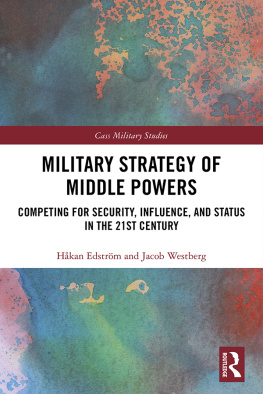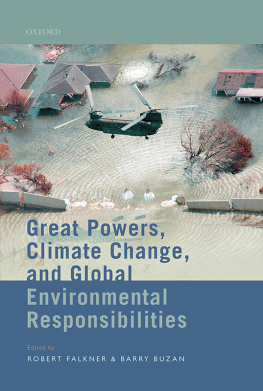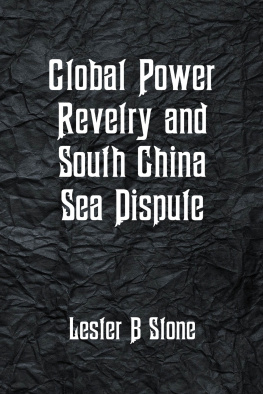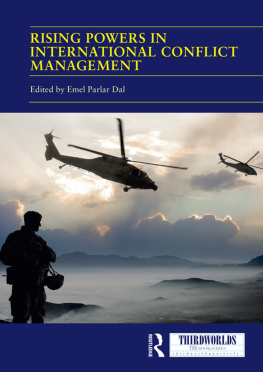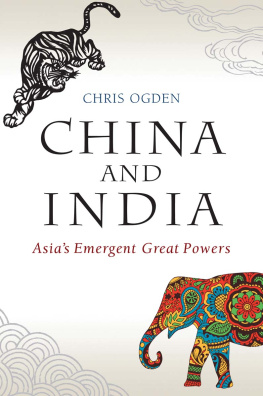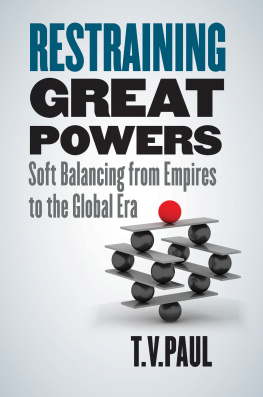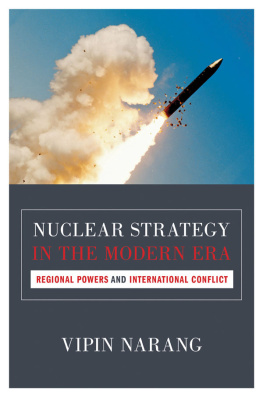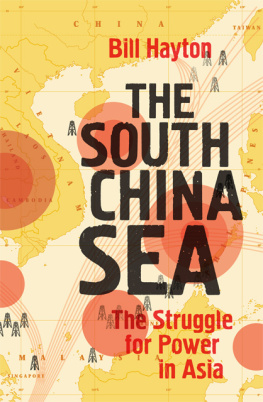


Naval Institute Press
291 Wood Road
Annapolis, MD 21402
2018 by Anders Corr
All rights reserved. No part of this book may be reproduced or utilized in any form or by any means, electronic or mechanical, including photocopying and recording, or by any information storage and retrieval system, without permission in writing from the publisher.
Library of Congress Cataloging-in-Publication Data
Names: Corr, Anders, editor of compilation.
Title: Great powers, grand strategies: the new game in the South China Sea / edited by Anders Corr.
Other titles: New game in the South China Sea
Description: Annapolis, Maryland: Naval Institute Press, 2018. | Includes bibliographical references and index. |
Identifiers: LCCN 2017038147 (print) | LCCN 2017051635 (ebook) | ISBN 9781682472361 (ebook)
Subjects: LCSH: South China SeaStrategic aspects. | South China Sea RegionHistory21st century. | Sea-powerChina. | Great powersHistory21st century. | Geopolitics. | Strategy. | BISAC: HISTORY / Military / Naval. | POLITICAL SCIENCE / International Relations / General.
Classification: LCC VA630 (ebook) | LCC VA630 .G74 2018 (print) | DDC 355/.033059dc23
LC record available at https://lccn.loc.gov/2017038147

 Print editions meet the requirements of ANSI/NISO z39.48-1992 (Permanence of Paper).
Print editions meet the requirements of ANSI/NISO z39.48-1992 (Permanence of Paper).
26 25 24 23 22 21 20 19 18 9 8 7 6 5 4 3 2 1
First printing
This book was made possible through the dedication of the U.S. Naval Academy Class of 1945.
Contents
Table of Contents
Guide

T he South China Sea is disputed through international law by seven claimant countries: the Peoples Republic of China (China), the Republic of China (Taiwan), Vietnam, the Philippines, Malaysia, Brunei, and Indonesia. These countries watch each others tactical and strategic choices, especially in the military, economic, diplomatic, and legal realms. Alliance decisions with great powers that operate in Southeast Asia often have more effect on the political dynamics of the South China Sea conflict than a countrys own military and economic capacity. For this reason, major powers globally take on great significance for what appears at first glance to be a purely local conflict. The nexus of major power grand strategies in the South China Sea is of interest to readers globally, especially among claimant countries. All interested parties try to assess and predict major power strategies and choices so as to optimize their own strategic choices in turn.
The South China Sea is simultaneously symbolic to broad segments of each claimant countrys citizens; home to potentially vast supplies of critical energy, fishing, and other natural resources; strategically sensitive for military forces, intelligence gathering, and coastal defense; a major transit area for international trade and communications; and a source of developing international case law. However, facts on the ground in the South China Sea are a function not just or even primarily of law, but rather of power. This volume distinguishes itself from the many books that primarily examine regional country legal claims and actions in the South China Sea. We examine the impact and grand strategies of major global powers in the conflict. For the purposes of this study, we define grand strategy as a set of plans to achieve a set of important state goals through the utilization of all its resources, including economic, diplomatic, and military means and interactions.
Major powers with influence on the South China Sea dispute, for the purposes of this volume, are the top five military spenders that operate significant military forces in the region. The European Union, which is one of the top two global economies and some of whose member states operate militarily in the South China Sea, and the Association of Southeast Asian Nations (ASEAN), which is diplomatically influential in Asia, are also included. The grand strategies of major powers and international organizations included in this volume have as much, or more, joint impact on the evolution of the South China Sea conflict than does any other factor. Yet no single volume to date has viewed the South China Sea conflict through this optic. In this volume, the authors demonstrate how major power struggle is the crux of the conflict and how claimant country interests are subordinated to the grand strategies of great powers, including China. We use the phrase South China Sea conflict rather than dispute because it is highly militarized and has already resulted in scores if not hundreds of deaths. A widening of the conflict, which all parties hope to avoid, could lead to war.
As much as we would like to see the Philippines United Nations Convention on the Law of the Sea (UNCLOS) arbitration award more thoroughly determine the outcome of the conflict, China simply ignored the 2016 decision and is relying instead on its own military maneuvers, economic influence, and threatening diplomacy. Chinas grand strategy in the South China Sea is redolent of what former U.S. secretary of defense Ashton Carter called a return to great power... competition... in the Asia-Pacific. Chinas coordinated, measured, and highly strategic belligerency at the expense of international law forces the Philippinesand the rest of the worldto look first to China and the United States, but also to other major powers and their strategies in the South China Sea, to navigate the likely evolution of the conflict. By ignoring international law, China has raised the stakes above what any single claimant country can afford and has thrown the dispute into the ring of major power diplomacy, economic statecraft, and military brinkmanship. While international law is critical to the outcome of the South China Sea conflict, other authors have written much on the subject. Beijings refusal to abide by the law requires a volume that focuses on Chinas choice of strategic endeavors in the South China Sea conflict (its military, diplomatic, and economic actions and influence) and how those tools interact with like endeavors by other major powers.
That the volume focuses on major powers does not mean that claimant countries such as Vietnam and the Philippines are left out. The Philippines is central to the conflict but is woven into the chapters, rather than having a chapter of its own. The same goes for Vietnam, Taiwan, and other claimant states. Given that South China Sea claimant countries that are members of ASEAN make efforts to resolve the conflict through changing major power grand strategies, we expect readers from those countries to welcome the focus of this volume.
This book is the first to focus on major power grand strategies, including economic, diplomatic, and military strategies, and their international interrelationships. The purpose of this focus is to explore the global nature of the South China Sea conflict and how global actors are interacting, contributing to the solution, and generating conflict. It draws on experts with regional knowledge of the major powers, as well as substantive and international experts to explicate interactions. Not all authors agree on all points, but all are eminently qualified and afforded the space to make their case.


